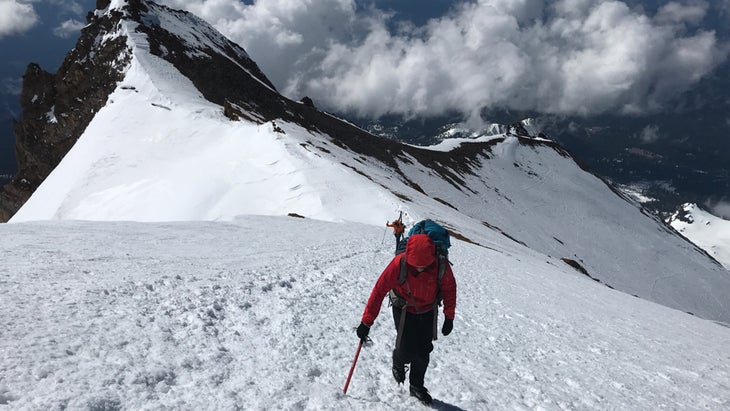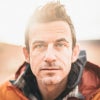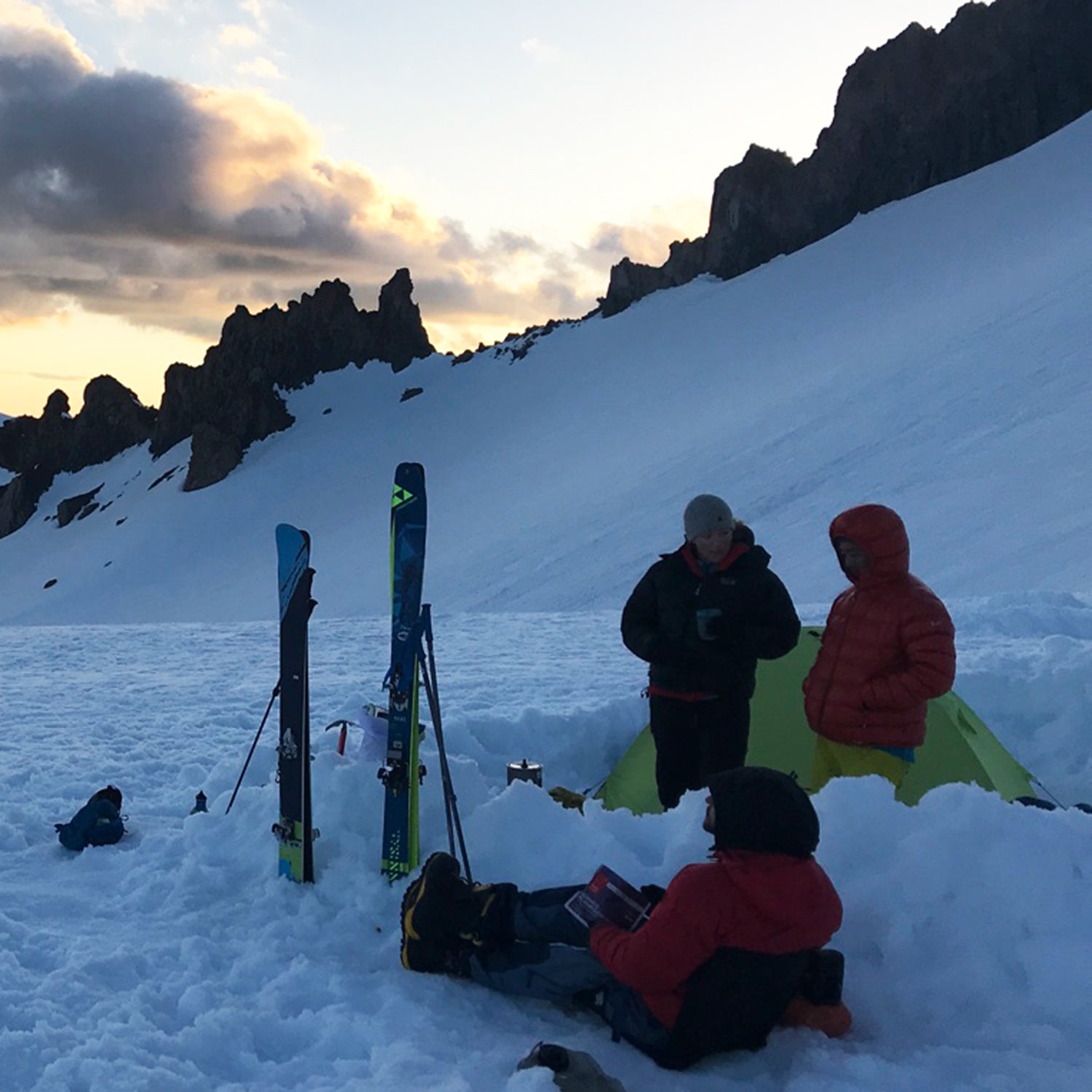It occurred to me, as Forest’s leg pressed against mine in the dark, a bit over the invisible line between our two sleeping pads, that I’d never had a comfortable night in a tent on Mount Shasta.
This time, May of 2018, was both uncomfortable and funny because of the size difference between my backpack and Forest’s. I had planned on using a nice, roomy , but a shipping snafu at the last minute meant it didn’t arrive in time, so I crammed as much as I could in a much smaller 38-liter pack and left out some things that definitely would have helped. Like an extra foam pad to put under my sleeping pad, an extra pair of socks to change into so my feet wouldn’t freeze in my sleeping bag, a thicker sleeping bag, extra layers, extra food, et cetera. Forest, on the other hand, had a massive backpack and was never one to shy away from overpacking. His rationale, as a photographer, was basically: I’m packing all these heavy lenses, so I might as well give up on having a light pack. On our many trips together, I have more than once glanced over in shock and awe at something he had apparently carried ten or more miles into the backcountry: a glass jar of tapenade, a quart of half-and-half, a pair of bulky leather moccasin slippers that he seemed to be taking everywhere lately, maybe more as a running gag than anything.
As soon as we’d gotten our small but bombproof mountaineering tent set up and anchored in the snow at Lake Helen, on California’s Mount Shasta, we discovered that the tent was designed for two regular-size 20-inch-wide sleeping pads. We discovered this because Forest had apparently acquired a super-plush 25-inch-wide pad, which was now monster-trucking over mine by almost five inches.
On the way to Lake Helen, I had drenched all my base layers and socks skinning uphill in the afternoon sun but hoped they might still have a chance to dry out in the brief couple of hours we had at camp before sunset. I wasn’t that lucky, and wriggled into my sleeping bag with a pair of damp ski socks between my knees in an attempt to dry them overnight. It was a short night, one of those nights when you aren’t freezing to death but just can’t quite manage to get good sleep because you’re just a bit too cold all night. And Forest was a bit over the line on my side of the tent or, more accurately, my 40 percent portion of the tent.
I had been on Shasta once before, on a fundraising climb in 2009, and I didn’t sleep well then either, but for different reasons: three guys sleeping shoulder to shoulder in a “three-person” tent, flatulence (night one’s dinner was bean burritos, and night two was lentil something or other), and nerves, because I had way less of an idea if I was capable of making it to the top of the mountain or not. We’d gotten up just after midnight on our summit day, climbed slowly in rope teams, made it to the summit, and then glissaded down for what felt like hours. It was my first time on a volcano, my first time on a rope team, and my first summit of Shasta. Before and after, my friend Mitsu kept talking about what a great ski descent it was. At the time, skiing it would have been a big leap for me skill-wise, and how would I even navigate up the route in the dark? I mean, our guide had even led us a bit off route in the dark that morning, to everyone’s surprise, including his. But maybe someday.
When I was in the fourth grade, my parents told my brother and me that we’d be going to Colorado to learn how to ski. We’d drive out from southwest Iowa over two days, stay in a four-bedroom condominium with three other families (the kids sleeping on the floor of the living room, the adults in the bedrooms), and the kids would take ski lessons for most of the week. I don’t know what drew our families to Steamboat, but I do know that with every adult lift ticket purchased, one kid 12 or younger skied for free. I think the first year I wore sunglasses in lieu of goggles and had a shoestring running through the sleeves of my jacket to my gloves, which was a pretty idiotproof way to not lose a glove.
I remember looking out the window of the condo that first evening and seeing the chairlift, wondering how people managed to stay on it on the way down the mountain. If I had asked my brother, he probably would have said something like, “You don’t ride it down, moron, you ski down.” And I would have said, “Oh, yeah.”
I hadn’t specifically trained for Shasta, aside from one day of skinning up a groomed run at Loveland Ski Area and a last-minute climb and ski of the Cristo Couloir on Colorado’s Quandary Peak, a fourteener I thought would be a good test to see if I was ready to ski Shasta. Test results: fit enough to climb up, not fit enough to ski down and look good doing it, but probably fit enough to ski down without my legs turning to complete Jell-O.
We learned how to snowplow/pizza and eventually how to do parallel turns/french fries, going from green to blue runs on rental skis, collecting less snow inside our jackets and pants as we figured out how to stay upright. I don’t remember specifically now, but I imagine my brother picked things up faster than I did, because he was more natural at pretty much every sport. By the end of the five days, we probably thought we were experts and started being those kids who would go straight down every blue run without a single turn if they could. We came back to Steamboat the next year and then took a trip to Winter Park when I was in the seventh grade.
I would never have said my family was rich—we seemed to be the last family I knew in the eighties to get a microwave and an answering machine—but maybe instead of a microwave, my parents wanted to go skiing. And now that I think about it, as an adult out on my own, I went a couple decades without owning a microwave, but I always had a pair of skis in my closet.
One other likely unintended consequence of those early trips: I left Iowa when I was 23 to live near the Rocky Mountains and have been unable to escape the gravitational pull of them ever since. I wouldn’t say skiing has ever been my number-one thing, but I think those early ski days planted a seed. When I returned to skiing again in my mid-twenties, my favorite part was no longer the whooshing down runs clear-cut through forests but the views from the top of all the other peaks and all the other possibilities for exploring, not just in the winter, but the next summer.
I moved back to Colorado in 2005 and logged 30 days on the mountain, learning to snowboard behind my friend Nick. In 2008, Nick and I took an American Institute for Avalanche Research and Education Level 1 avalanche course, and I got a pair of bulky alpine touring bindings for cheap, mounting them on an old pair of skis my friend Mitsu sold me for $100. I skied a handful of days each year, a few at resorts and a few in the backcountry in the spring, when the snow had consolidated and avalanche danger was lower.
In 2017, I started climbing and skiing a volcano every year with Mitsu, first the Southwest Chutes of Washington’s Mount Adams, a 35-to-40-degree line that keeps going and going for 4,000 vertical feet, and then Oregon’s Mount Hood (I downclimbed a couple hundred feet of the Old Chute route before clicking into my skis, looking at the bergschrund at the bottom and not feeling confident I’d make the consequential turns). I loved the snow climbs, and I loved skiing down instead of walking.
For 2019, I had started to think about Shasta, and Forest and I were looking for a snowy location for a photo shoot for a book we were writing about camping. Mitsu was in, too. I also invited our friend Abi, who lived in Northern California and had been partway up Shasta three times but never summited for various reasons. She had a young son at home and hadn’t been getting out as much as she used to, but I figured we’d pace ourselves and she’d be OK. I did forget that the weekend we’d be on Shasta was Mother’s Day weekend, but her husband, Eddie, was up for doing a guys’ weekend with their son in order to help Mom get up a big snowy mountain.
As I strapped my skis to my pack at the Bunny Flat Trailhead on Shasta’s southwest flank to walk the first couple miles of trail, I started to realize I was more excited to help Abi finally get to the summit than I was about taking a shot at skiing the mountain myself. It’s one thing to try something and have to turn back once, but twice, and then three times, it starts to build up. And with a young family, and maybe your friends all starting to have young families and spend less time climbing mountains, it might get to the point where you think you might not get back to try, let alone summit. But I thought our plan was good: take two days, hike up to Lake Helen the first day, camp, and then go for the summit in the morning—a pretty standard itinerary for the Avalanche Gulch route, the most popular route on the peak. Abi wasn’t sure if she’d try to ski down, but I figured she could probably glissade as fast as I could ski, or at least fast enough.
I hadn’t specifically trained for Shasta, aside from one day of skinning up a groomed run at Loveland Ski Area and a last-minute climb and ski of the Cristo Couloir on Colorado’s Quandary Peak, a fourteener I thought would be a good test to see if I was ready to ski Shasta. Test results: fit enough to climb up, not fit enough to ski down and look good doing it, but probably fit enough to ski down without my legs turning to complete Jell-O. As I crammed extra clothing in my ski bag for my flight to California, I thought about the idea of telling nine-year-old me during my first week on skis that you could use them to ski uphill. It would have blown my mind—and sounded like the dumbest idea ever.

From our campsite at Lake Helen, which we shared with a dozen or so other climbers, I looked up at the route. Mitsu and Abi melted snow for cooking and drinking water, and Forest shot a few photos. We’d been hot on the ski up to the campsite at 10,400 feet, the sun bouncing off all the snow at our feet and then onto our faces, but as soon as the sun went down, the temperature would drop and the soft snow at the campsite would harden to ice overnight.
Mitsu, in a rush to pack and leave his home in Portland, Oregon, had forgotten his crampons and thought he might be able to make do with his ski crampons. But he also had a splitting headache and was drinking a cup of coffee in a desperate hope that maybe the caffeine would help.
I remembered wondering back in 2009 how the hell I’d find my way up the steep snowy slope in the dark, and the answer seemed funny now: we’d leave camp later. We were in decent shape, knew how long it would probably take us to get to the summit, and there were only four of us, climbing unroped. In 2009, I had trained for my Shasta climb by hauling a heavy pack up a steep hike near Denver once a week, figuring that was a good simulation. This time I had hardly trained at all, and I was at least partly counting on knowing how to pace myself, something that had come with a lot of experience—and the lesson from our Shasta guides that going slow and not stopping was way better than going fast and having to stop and catch your breath every couple hundred feet.
The next morning, we got up at five to stomp around in the cold and make oatmeal and coffee in the dark. One by one we left camp, figuring we’d be able to keep tabs on each other pretty easily in the wide-open gully. I started on my skis, skinning at a comfortable pace, then eventually popped them off and put crampons on my ski boots. Abi and I kept fairly close to each other all the way up, and Mitsu made it about two-thirds of the way to the top of the gully before throwing in the towel—he didn’t feel good about trying to finish the climb without crampons.
Abi and I made it to the top of Avalanche Gulch, heading around the Red Banks and plopping down in the snow for a break before the final 1,300-foot climb to the summit, which was less steep but maybe more miserable due to the decreased availability of oxygen higher up. I scanned the sky to the west looking for clouds, checked my phone for the elevation, and tried to estimate how much longer we might be climbing before we hit the summit. Abi, having crushed out 2,500 feet of climbing despite multiple warnings to us that she did not think she was in peak physical condition for something like this, tried to eat Cheez-Its and updated me on how things were going in regards to menstruation and lactation: “I’m bleeding into my pants, and I’m going to need to milk myself when we get down.”
I talked with Abi about apps that help you track your menstrual cycle, which is not something I thought I’d ever discuss with someone on the side of a mountain, and I thought about something my friend Jayson told me once in a discussion about traveling. He had been telling me about walking out of a tent to board a plane at the airport in Nairobi, Kenya, which was under construction at the time. I said something about how it sounded crazy compared to what we consider normal air travel, and he told me he realized that whenever he had anxiety about traveling somewhere new, with all the things you think about—passports, visas, not knowing the language, not knowing how to get around a new country or a city, and generally feeling like a very nervous fish out of water—he’d see a mom juggling all the same stuff he was juggling while traveling, plus a kid or two, and looking like she wasn’t worried at all.
We climbed the next thousand feet up Misery Hill, a slope that everyone will tell you feels like it’s never going to end, Abi just behind me and Forest just behind her, until we arrived at the final rocky crown of the peak, bordered by a steam vent leaking rotten-egg-smelling sulfuric air everywhere.
Abi and I set our packs down in the snow to trudge up the final 300 rocky vertical feet to the summit of Shasta. The snowy climbers’ trail ended a few scrambly moves from the proper summit. I said Abi should go first, because it was her first time up there and it was more important, and she said no, you go first, because if I watch you do it, the exposure won’t seem so bad. I stood my ground, and finally Abi went for it, stopped to take in the view, and let some tears run down her cheeks. Forest popped his head up from around the corner behind me, and he and I moved up to the summit to take a photo with Abi.
After a few minutes, we picked our way down the summit and back to our packs. Some guys who had come up just behind us put on their skis on the actual summit and made a scrappy turn or two off the top before continuing down. For about half a second, I wondered if I should have tried to ski off the real summit, but the idea flitted away immediately, because I’d gotten what I came for: a supporting role in helping my friend get to the top.

I clicked into my skis, Forest strapped on his splitboard, and we made our descent, stopping every few minutes to make sure Abi was doing OK plunge-stepping and glissading down, until we finally made it back to our tents at Lake Helen.
I’ve always seen Shasta as a sort of slightly more friendly volcanic cousin of Mount Rainier, at least by each mountain’s trade route—Shasta is a couple hundred feet lower, and the climb is a bit shorter in both mileage and elevation gain. But Shasta is interesting on its own, in both the climbing and skiing and the many , which range from UFOs to lizard people to the ancient city of Telos that some claim lies under Shasta. I can’t speak to any of that other stuff, but I can say that I get why people like to tell stories about mountains.
Brendan Leonard’s new book, Bears Don’t Care About Your Problems: More Funny Shit in the Woods from , is . This piece is the 11th in a celebrating ten years of his blog at Semi-Rad.com.


